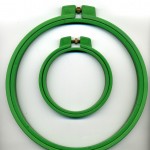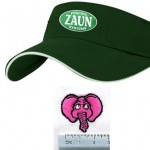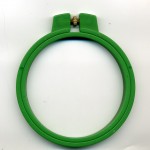Almost everything in our catalogue is priced to include an embroidery in the typical position. We try to mention the standard embroidery position for each garment or item on it’s product page. Polo shirts for example are usually embroidered on the left breast.
We can also embroider in other “non standard” positions such as the sleeve of a polo shirt for example and are often asked about doing things like this.
To put a garment into the embroidery machine it has to be framed. Embroidery frames are round hoops and come in various sizes with the smallest having a 6cm diameter. Where we can and can’t embroider is down to the framing of the garment.
The maximum size we can possibly embroider is determined by the largest frame we can get into the garment. A polo shirt, t-shirt or pretty much any garment you would embroider on the left breast has nothing obstructing it from being framed. For left breast embroideries we usually use a size 15 frame which allows us to embroider at whatever size is needed.
We are limited to smaller frame sizes on smaller items like golf towels or visors for example. Golf towels are only big enough to accommodate a size 12 frame, therefore we can only embroider at up to 10cm wide on them. Visors are very fiddly to frame up and only allow us a certain amount of room to embroider on the front as shown in the picture. Head wear such as caps and visors are actually framed differently with specific frames.
Zips and seams on items like bags for example restrict framing. A frame can not go over a zip so the top of the frame can only be placed as high as the zip allows. That means that there is also less room left for the frame, forcing a smaller one to be used. Sleeves can be embroidered so long as we can fit a frame inside them, for adults sizes this is not a problem but for children’s sizes as they get smaller there is less room for the frame. Shirt pockets can be embroidered but the size is again limited as we have to hoop through the pocket, unless we want to stitch the pocket closed to the shirt.
The frames themselves are about 1cm wide and we need to leave around another 1cm clearance so that the machine doesn’t hit the frame. So if the largest frame we can get into, say a shirt pocket, is a 6cm frame then the largest embroidery design we can fit inside it is 4cm wide.
It gets complicated so the best thing to do if you have a requirement is just to ask us.


